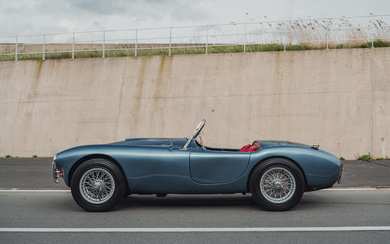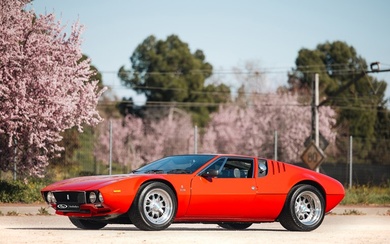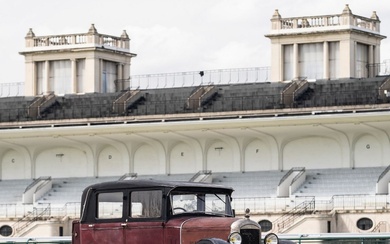1958 AC Ace-BristolChassis no. BEX436Engine no. 100D2 805
1958 AC Ace-BristolChassis no. BEX436Engine no. 100D2 805
1,971cc OHV Inline 6-Cylinder Engine3 Solex Downdraft Carburetors 130bhp at 5,750rpm 4-Speed Manual Transmission 4-Wheel Independent SuspensionFront Disc - Rear Drum Brakes *Fine example of the original Ac Ace-Bristol Roadster*Previously in the John Moir Collection*Highly original, retaining matching-numbers engine, driveline and bodywork*Eligible for some of the most desirable concours and driving events*Recent mechanical refurbishment by Steve BabinskyTHE AC ACE-BRISTOL"Of them all, the Ace was the truest sports car: it could be used for daily commuting or for high-speed long-distance touring, but it could also be driven to a race meeting, campaigned with distinction, and driven home again - even if that race was the Le Mans 24 Hours." - AC Heritage, Simon Taylor & Peter Burn. The success of Cliff Davis's Tojeiro sports racer prompted AC Cars to put the design into production in 1954 as the Ace. The Davis car's pretty Ferrari 166-inspired Barchetta bodywork was retained, as was John Tojeiro's twin-tube ladder frame chassis and Cooper-influenced all-independent suspension, but the power unit was AC's own venerable, 2-liter, long-stroke six. This single-overhead-camshaft engine originated in 1919 and with a modest 80bhp (later 100bhp) on tap, endowed the Ace with respectable, if not outstanding, performance. In 1955, AC added a hardtop version—the fastback-styled Aceca—and from 1956 onwards both models became available with the more powerful Bristol 2-liter, six-cylinder engine with its ingeniously arranged, pushrod-operated inclined valves. Although taller and heavier than AC's own engine, the BMW-based Bristol was considerably more powerful thanks to its superior cylinder head design and down-draught carburetors. Up to 130bhp was available from the Bristol unit in road trim, in which form the Ace could touch 120mph (195km/h), while around 150bhp could be wrung from it for racing. The Bristol-engined Ace was not only more powerful, it was also considerably more expensive, costing £2,011 in 1957, an increase of 22% over the price of the AC-engined version. For that you could buy two MGAs, and even Jaguar's XK140 was cheaper than the Ace Bristol. Nevertheless, by the time Ace production ceased in 1963, more than half the 723 cars built had left the factory fitted with Bristol engines. The combination of a fine-handling chassis and a decent power-to-weight ratio helped the Ace to numerous successes in production sports car racing. Arguably, its finest achievement being a first-in-class and seventh overall finish at Le Mans in 1959. Indeed, its basic soundness and versatility were reflected in the fact that relatively few major changes were found necessary when the Ace was endowed with Ford V8 power to create the legendary Cobra. THE MOTORCAR OFFEREDThis desirable AC Ace-Bristol Roadster left the factory equipped with a left-hand drive steering arrangement, just as it appears today. Reportedly, the car was destined for the Canadian market, and sold new to a Mr. Gold. After Mr. Gold passed away, his widow would sell BEX436 on, and it eventually ended up in the hands of legendary collector car dealer and racing driver, Mr. Kirk F. White. In 1988, the matching numbers and well-kept AC Ace-Bristol was sold to renowned collector Mr. John Moir, with whom the desirable Roadster would remain until acquired by the consignor - a Philadelphia-based collector of exceptional collectors' motorcars of all eras - in 2014. Today, this desirable factory left-hand-drive AC Ace-Bristol is sporting the lovely Dark Blue paint and black leather interior it wears so well. It is fitted with correct and appropriate wire wheels shod on classic Michelin tires. Instruments and gauges appear original and untouched, and the classic 3-spoke banjo-type wood rimmed steering wheel gives one great grip in tight corners. BEX436 is a factory delivered, left-hand-drive example, which retains its original chassis and engine tags, along with all other factory stampings. It is indeed a well-cared for example, which has never seen abuse or neglect, and remains matching-numbers with the original aluminum bodywork intact. The car is offered with tools, side curtains and soft top. A traditional English sports car in every sense of the word, this AC Ace-Bristol Roadster satisfies every need of a true motoring enthusiast: a smooth inline-6, swooping aluminum bodylines, and wind in your face. A fine and genuine example such as this will continue to be an object of desire for many decades to come.
View it on
Estimate
Time, Location
Auction House
1958 AC Ace-BristolChassis no. BEX436Engine no. 100D2 805
1,971cc OHV Inline 6-Cylinder Engine3 Solex Downdraft Carburetors 130bhp at 5,750rpm 4-Speed Manual Transmission 4-Wheel Independent SuspensionFront Disc - Rear Drum Brakes *Fine example of the original Ac Ace-Bristol Roadster*Previously in the John Moir Collection*Highly original, retaining matching-numbers engine, driveline and bodywork*Eligible for some of the most desirable concours and driving events*Recent mechanical refurbishment by Steve BabinskyTHE AC ACE-BRISTOL"Of them all, the Ace was the truest sports car: it could be used for daily commuting or for high-speed long-distance touring, but it could also be driven to a race meeting, campaigned with distinction, and driven home again - even if that race was the Le Mans 24 Hours." - AC Heritage, Simon Taylor & Peter Burn. The success of Cliff Davis's Tojeiro sports racer prompted AC Cars to put the design into production in 1954 as the Ace. The Davis car's pretty Ferrari 166-inspired Barchetta bodywork was retained, as was John Tojeiro's twin-tube ladder frame chassis and Cooper-influenced all-independent suspension, but the power unit was AC's own venerable, 2-liter, long-stroke six. This single-overhead-camshaft engine originated in 1919 and with a modest 80bhp (later 100bhp) on tap, endowed the Ace with respectable, if not outstanding, performance. In 1955, AC added a hardtop version—the fastback-styled Aceca—and from 1956 onwards both models became available with the more powerful Bristol 2-liter, six-cylinder engine with its ingeniously arranged, pushrod-operated inclined valves. Although taller and heavier than AC's own engine, the BMW-based Bristol was considerably more powerful thanks to its superior cylinder head design and down-draught carburetors. Up to 130bhp was available from the Bristol unit in road trim, in which form the Ace could touch 120mph (195km/h), while around 150bhp could be wrung from it for racing. The Bristol-engined Ace was not only more powerful, it was also considerably more expensive, costing £2,011 in 1957, an increase of 22% over the price of the AC-engined version. For that you could buy two MGAs, and even Jaguar's XK140 was cheaper than the Ace Bristol. Nevertheless, by the time Ace production ceased in 1963, more than half the 723 cars built had left the factory fitted with Bristol engines. The combination of a fine-handling chassis and a decent power-to-weight ratio helped the Ace to numerous successes in production sports car racing. Arguably, its finest achievement being a first-in-class and seventh overall finish at Le Mans in 1959. Indeed, its basic soundness and versatility were reflected in the fact that relatively few major changes were found necessary when the Ace was endowed with Ford V8 power to create the legendary Cobra. THE MOTORCAR OFFEREDThis desirable AC Ace-Bristol Roadster left the factory equipped with a left-hand drive steering arrangement, just as it appears today. Reportedly, the car was destined for the Canadian market, and sold new to a Mr. Gold. After Mr. Gold passed away, his widow would sell BEX436 on, and it eventually ended up in the hands of legendary collector car dealer and racing driver, Mr. Kirk F. White. In 1988, the matching numbers and well-kept AC Ace-Bristol was sold to renowned collector Mr. John Moir, with whom the desirable Roadster would remain until acquired by the consignor - a Philadelphia-based collector of exceptional collectors' motorcars of all eras - in 2014. Today, this desirable factory left-hand-drive AC Ace-Bristol is sporting the lovely Dark Blue paint and black leather interior it wears so well. It is fitted with correct and appropriate wire wheels shod on classic Michelin tires. Instruments and gauges appear original and untouched, and the classic 3-spoke banjo-type wood rimmed steering wheel gives one great grip in tight corners. BEX436 is a factory delivered, left-hand-drive example, which retains its original chassis and engine tags, along with all other factory stampings. It is indeed a well-cared for example, which has never seen abuse or neglect, and remains matching-numbers with the original aluminum bodywork intact. The car is offered with tools, side curtains and soft top. A traditional English sports car in every sense of the word, this AC Ace-Bristol Roadster satisfies every need of a true motoring enthusiast: a smooth inline-6, swooping aluminum bodylines, and wind in your face. A fine and genuine example such as this will continue to be an object of desire for many decades to come.






